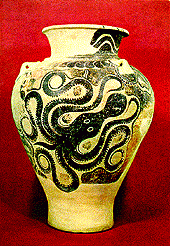

M. S. QUINBY-HUNT
Lawrence Berkeley Laboratory
Berkeley, California
Quinby-Hunt and Wilde (1994, 1996) proposed a redox-pH zonation of sediments derived from a Phanerozoic black shale data base. The chemistry of the shales reflects the range of environmental conditions governed by atmospheric and oceanic chemistry of the time. However, these conditions were the result of chemical evolution of the atmosphere and oceans in the Precambrian. Accordingly certain conditions did not exist earlier. By examining elemental compositions on older sedimentary rocks, we propose that the abundance of sediments in each zone changes with major events that effect ocean chemistry. As the original framework was based on thermodynamics, the fundamentals of each zone are the same. For example, the high-organic highly-reduced Zone IV (typified by the 'black shale facies') is relatively uncommon after the Devonian. Also, associated mineralogies and elemental abundances within each zone may change with the evolving geochemistry as a result of the combination of tecto-chemical and biological events. The tecto-chemical changes occur as part of the continuum of change from the greenstone sediment source (sima) to that from predominantly granitic (sial) continents. Major biological events which modify the atmospheric and oceanic redox are the evolution of marine photosynthesis, sulfate reduction, and land plants. We suggest four basic clusters of conditions: (a) Early Earth (Archean): no photosynthetic life; no atmospheric oxygen, limited continental differentiation, greenstone continents; (b) Early Proterozoic: photosynthesis, developing atmospheric oxygen, begin shift from greenstone continents to more granitic; (c) Late Proterozoic-Devonian: oxygen levels approaching modern, more granitic continents; (d) Devonian-Recent: with the development of land plants, the atmosphere approaches the modern composition, as does the ocean; the continents become more granitic. Preliminary estimates of abundances in the rock record are given below.
Interval I II III IV Bio-Event Dominant Parent Rock Post Devonian-Recent C P P+ R Land Plants Granite Late Proterozoic-Devonian P C C C Sulfate Reducers Granite Early Proterozoic R P+ C C Marine Photosynthesis Basalt Archean 0 P C+ C Sulfur Bacteria Basalt
Redox Zones I through IV (More anoxic to the right)
Order of Abundance in Sediments
0 = non-existent; R=rare; P = present; C =common